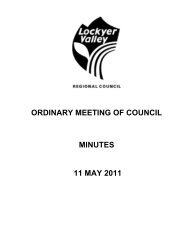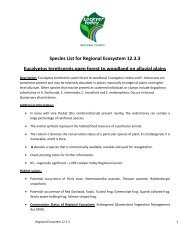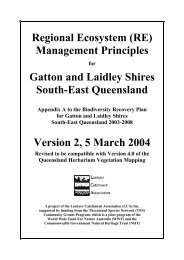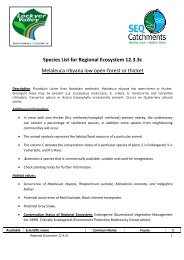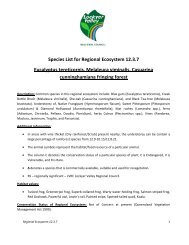Biodiversity Recovery Plan - Lockyer Valley Regional Council
Biodiversity Recovery Plan - Lockyer Valley Regional Council
Biodiversity Recovery Plan - Lockyer Valley Regional Council
You also want an ePaper? Increase the reach of your titles
YUMPU automatically turns print PDFs into web optimized ePapers that Google loves.
1.0 Approach and scope of recovery plan<br />
The introduction of the Commonwealth Environment Protection and <strong>Biodiversity</strong><br />
Conservation (EPBC) Act 1999 has substantially strengthened the role and effectiveness of<br />
threatened species and ecological community recovery planning. Arguably the most<br />
significant innovation is the ability to prepare multi-species, local or regional recovery plans.<br />
These new approaches and their benefits are introduced in the Environment Australia booklet<br />
How to Go About Preparing a <strong>Recovery</strong> <strong>Plan</strong>:<br />
Traditionally recovery plans have been prepared for a single species covering its entire<br />
range. This may not always be the most effective way of taking action to protect<br />
threatened species or ecological communities. Where feasible, the Commonwealth is<br />
therefore encouraging the development of multi-species, local or regional recovery<br />
plans that focus on particular actions to protect the populations of threatened species in<br />
a specific area. Often species that occur in the same region are subject to the same<br />
threats. A set of actions directed towards combating those threats will benefit multiple<br />
threatened species. The advantage of a local, multi-species or regional approach is that<br />
it can focus efforts on specific populations of animals and plants and can develop local<br />
community campaigns to help implement the necessary recovery actions. Further<br />
benefits include the avoidance of duplication, greater efficiency and cost-effectiveness,<br />
and the ability to bring together a broader range of interested groups and individuals.<br />
The favoured approach for scoping a recovery plan should be one that most efficiently<br />
meets the particular recovery requirements of the species, group of species or<br />
ecological communities covered.<br />
The <strong>Biodiversity</strong> <strong>Recovery</strong> <strong>Plan</strong> for Gatton and Laidley Shires, South-East Queensland 2003-<br />
2008 implements the multi-species and local approaches by carrying out recovery planning<br />
for all of the significant species and ecological communities within defined Local<br />
Government areas:<br />
Local recovery planning The recovery plan covers the Local Government<br />
areas of Gatton and Laidley Shires and focuses on<br />
actions to combat the common threats to the<br />
significant species and ecological communities in<br />
the Gatton and Laidley Shire area.<br />
Multi-species recovery planning The recovery plan covers all of the significant<br />
species and ecological communities within Gatton<br />
and Laidley Shires, including threatened species and<br />
ecological communities listed at National and State<br />
levels and species with regional significance.<br />
Gatton and Laidley Shires are located within, and comprise most of the land area of, the<br />
catchment of <strong>Lockyer</strong> Creek. The <strong>Lockyer</strong> Catchment is located approximately 100 km west<br />
of Brisbane, South-East Queensland and is part of the wider Brisbane River Catchment.<br />
Parts of the 295,400 ha <strong>Lockyer</strong> Catchment have been cleared for intensive agriculture and<br />
grazing, resulting in the extensive loss and fragmentation of native vegetation communities<br />
4



